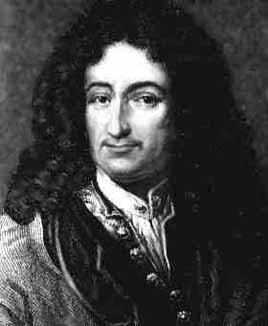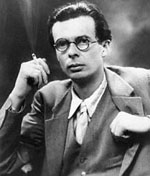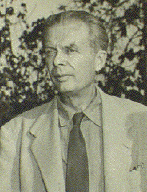As will be clear by now, this is an interdisciplinary sort of course, a course which brings together some observations about Religious Studies, Philosophy and about Art, and not just any art, but sacred art, iconic art in some cases. We now have the background to get clear about the sort of Philosophy we have been discussing and the sort of Art we are interested in.
Were we discussing any old art or art in general, we would have one
set of definitional problems, but "sacred" art presents a unique problem,
because we need to figure out what we mean by "sacred" before
we can even apply it to the idea of art, or to specific arts. And to do
this we need to ask if there is a philosophy which deals with things which
could be called "sacred?"
| In modern times, this is not at all easy, because much philosophy is intentionally only concerned with issues which might best be called secular or scientific in character. But there is a stream in the philosophical world that is concerned with the sacred, or perhaps we might say the spiritual or the religious -- in this essay we will use these terms interchangeably. This stream goes by the name of "The Perennial Philosophy" and dates back in that guise to Leibniz (1646 - 1716). |  |
In its 20th century formulation The Perennial Philosophy was most popularly articulated by a British writer by the name of Aldous Huxley, who defined the Perennial Philosophy on the first page of his very influential book of the same name in this way:
"Philosophia Perennis - the phrase was coined by Leibniz; but the thing -- the metaphysic that recognizes a divine Reality substantial to the world of things and lives and minds; the psychology that finds in the soul something similar to, or even identical with, divine Reality; the ethic that places man's final end in the knowledge of the immanent and transcendent Ground of all being -- the thing is immemorial and universal. Rudiments of the Perennial Philosophy may be found among the traditionary lore of primitive peoples in every region of the world, and in its fully developed forms it has a place in every one of the higher religions. A version of this Highest Common Factor in all preceding and subsequent theologies was first committed to writing more than twenty-five centuries ago, and since that time the inexhaustible theme has been treated again and again, from the standpoint of every religious tradition and in all the principle languages of Asia and Europe."
This definition may seem a bit dense, and perhaps not at all relevant to the character of this course, but bear with me while we explore this formulation in some greater depth and it will become clearer.
| So to begin, who was Aldous Huxley, and what led him to formulate what many may consider a rash idea? Huxley was born on July 26, 1894 in England and moved to Southern California in 1947, where died on Nov. 22, 1963. He was a member of a distinguished scientific and literary family and is remembered primarily as a novelist and essayist. The book Perennial Philosophy was first copyrighted in 1944 -- so we know it was written in the shadow of the Second World War. The definition of the Perennial Philosophy Huxley gives, and which is quoted above, betrays the powerful influence the thought of ancient India, and particularly the class of literature known as the Upanishads, had on him. |  |
 |
In this we must recognize a funny irony, in that while England had colonized India and exploited it economically (in fact almost mercilessly), by the mid-1940s not only was England on the verge of relinquishing its hold on India, but was in fact experiencing India's intellectual colonization of England through literati such as Huxley. One might say that the book represents an early example of that colonization.
But the process was not only taking place in England. All the major European powers had sought colonial empires as an adjunct to wealth and world influence. The French controlled vast regions of Southeast Asia, as well as North Africa. So it was from North Africa, perhaps because of greater proximity to France than Southeast Asia, that a reverse intellectual colonization took place. In the case of the French it was mystical Islam (ie, Sufism) that was the intellectually colonizing power, spreading out from France through continental Europe and appearing as a sort of postmodern Neoplatonism in the pre- and post-second world war books of writers such as Rene Guenon, Frithjof Schuon, and Titus Burckhardt.
Decades later, the American occupation of Japan brought a backwashing wave of Buddhism to the attention of the generation which matured in the early years of the American economic empire. But in the case of the USA, and unlike the case of the European world, at the same time the Zen wave was appearing on the American horizon, so were the books of authors such as Huxley and Schuon, or the very authors themselves! A generation of notable American exponents of the Perennial Philosophy arose during and after the 1950s, such as Huston Smith (who, in his autobiography, acknowledges the influence of Aldous Huxley), Philop Novak (Huston Smith's student) or Jacob Needleman (cf, The Sword of Gnosis); and all were influenced not just by by Huxley, but also by Schuon, etc., as well as by actual encounters with Hinduism, Buddhism and Islam, thus creating an embracing spiritual vision not unlike their own country's embracing vision of world democracy.
So in this class, when we ask, as we must, "what makes art sacred rather than secular?" we will be guided by all these streams. Or perhaps it might be better to think not of streams, but waves on a lake, each separate wave scintillating with its own light, yet all reflecting a single sun, albeit from a slightly different angle. In fact such a metaphor is a perfect simile for the Perennial Philosophy itself. For Huxley wrote of it as "a divine Reality (ie, sun) substantial to the world of things and lives and minds (ie, waves)."
In the Upanishadic vision of this Philosophy, God is the only Reality which can possibly exist, and all the multiplicity of "things and lives and minds" we see around us are just that very God in disguise as the mundane, the secular -- which makes the secular somehow false, or as the Upanishads call it, "maya". In the Buddhist vision, things and lives and minds appear in an ordinary aspect because of our own mis-cognition of them, while in their own right they inter-depend in a grand unfolding pattern -- no underlying God being required to either direct the process of unfolding, or create what is being unfolded. The Sufic vision is more akin to the Hindu than the Buddhist, taking the Islamic revelation that there is nothing apart from God (ie, "There is no god but God") from the realm of theology to that of immediate experience. It is within the context of this vision that Burckhardt writes, seeking to distinguish secular appearances and artistic practices from sacred appearances and artistic practices, a world of gods from a world of God. And here "gods" is meant in the sense not of world-creators, but of things being worshipped that are not Godly. In other words, the religion of materialism that seems to be choking the modern world.
Hence Burckhardt and his colleagues ask us to reflect on the problem of individuality and individualistic vision in the creation of art. Does the artist worship the god of his/her own ego?, her/his own vision?, or worship the God that underlies all appearances?, the God that expresses itself in the formal character of the principles underlying appearances?
But, just as there are multiple scintillations on our metaphoric lake, each with its own angle of reflection of the sun, so we will find ourselves and our vision enriched by reviewing the Buddhist answer to our question about the distinction between sacred and secular. This is why we read Professor Robert Thurman's profoundly visionary essay on the psychological aspects of Tibetan Buddhist Art. Here we find a twist on the Perennial Philosophy, and a position seemingly opposite from Burckhardt's concerns about the worship of gods, rather than God, for in Thurman's vision of Tibetan art the rules of iconic form are applied to the elaboration and exploration not so much of a sacred world which stands apart from our secular world, but of a secular world which itself can be transformed into a sacred realm (hence the title of the book from which the essay is drawn, Worlds of Transformation). That is, for Thurman, art is a tool to sacralize the secular world, to make the secular into the sacred! As Thurman describes the Buddhist vision, the difference between the sacred and secular worlds merely arises from the angle of our own vision -- seen from one angle the world is secular, while seen from another angle, it is sacred (for those of you who have encountered this, Thurman bases his vision on the Two Truths theory of Buddhism). And so, in this view the function of sacred art is not to be a vehicle for expressing a personal, creative vision of an alternative to the secular world, nor is it a vehicle for escaping from the secular world, but rather it is a vehicle for transforming the secular into the sacred, for re-imagining our world not as a materialistic hell of competition for limited resources, but as an abundant Garden of Eden capable of nurturing all its residents.
So, in general, when we begin to apply the definitions of "sacred" which arise out of the Perennial Philosophy to examples of artistic process, we are asking, essentially, to what extent does a painting, sculpture, genre of art, etc., express this hidden, underlying "divine Reality substantial to the world of things and lives and minds", this Unity which embraces and holds-together the multiplicity which we experience as our existence. If it does this, we will define that art as spiritual or sacred. If it does not, we will define it as secular or psychological.
These are not absolute definitions, clear categories nicely insulated from each other. As we review traditional and contemporary arts we find that the categories overlap, and we have some difficulty distinguishing, for example, the psychological from the sacred.
So, to further clarify the distinctions I have been making, our next step will be to refine our ideas about the perennial philosophy, about the distinction between the secular and the sacred (or we may also say, the spiritual or the religious).
To refine our understanding of the Perennial Philosophy, let's let Huxley be our guide.
Now, as Huxley indicates in the essay we have just read, the first of the four fundamental doctrines associated with the Perennial Philosophy is that "…. the phenomenal world of matter and of individualized consciousness - the world of things and animals and men and even gods - is the manifestation of a Divine Ground within which all partial realities have their being, and apart from which they would be nonexistent." The implication here is that everything we can know in an apparently objective way is, in fact, merely a partial aspect of a fuller, divine whole. We must then, in a recursive way, recognize that this notion must apply not only to all knowable objects, but also to all ideas, and systems of ideas, as well as the broadest systems of ideas we have, such as entire religions. This also has significant implications then for any comparative study of sacred art, such as this course, because no one religion or sacred tradition of art in any one religion can conceivably be complete if the religion itself is only a partial truth.
This might seem to end our enterprise before it begins, because we must ask "how can we arrive at anything but flawed conclusions about sacred art if the religious traditions we reference are themselves limited, partial, and thus, dare we say, flawed and inaccurate?
But here the Perennial Philosophy comes to our assistance, and offers a context for comparative study, a methodology for the endeavor.
One of the writers referenced above, Huston Smith, has formulated the methodology which will assist us in his classic book "The World's Religions." We may call the approach "Many Paths to the Same Summit."
Thus, equipped with Smith's methodology, finally we can retrospectively reflect on the structure of our course, which follows that methodology, and which method is in fact the organizational structure of this course.
If we follow Smith, and assert that all religions or spiritual systems are viable paths to realizing the divine ground which underlies experience, then all these systems will have an art which assists in traversing these paths. However, we also recognize that each path or artistic tradition is in some way limited, or even flawed and inaccurate. Due to this necessary limitation, the "rules" which govern the creation of art in one religion or spiritual system, as well as the artistic products themselves, can be radically different than those of another system -- in fact oppositional -- yet each in themselves equally "true" and useful in achieving the goal of "knowing the Divine ground" directly.
In addition, given Huxley's third of four fundamental doctrines of the Perennial Philosophy, that "man possesses a double nature", we may conclude that some art is more resonant or attuned to the phenomenal ego (i.e., is secular), some to the Divine Ground, and probably most somewhere between the two. This conclusion produces some interesting possibilities. What I have called "psychological art" might at first thought be presumed to be art which relates to the ego, and so be "secular" in nature. But C. G. Jung has proposed that the resolution of problems on the personal level makes one more whole, more open and transparent. Or, as the Buddhists would say, the resolution of these personal problems removes the coverings and obscurations that hide the Divine Ground. That is to say, psychological art is ambivalent in the literal sense of "dual directional." It views or looks upon both the personal and the divine at the same time, somewhat like double-exposed or superimposed photographic images. As the personal level is clarified and personal problems are resolved, the sacred level is more fully revealed. If we link this idea with the idea that all religions or spiritual systems are viable paths to realizing the Divine Ground which underlies experience, then we may also conclude that the varieties of psychological art (for example, the variety of stories about the quest) are not sacred in character (as is, say, iconic art) but are steps in the direction of a spiritual path, rather than steps on one of the paths. We may here think of a cross …. + …. in which the horizontal line is psychological and the vertical line is spiritual or sacred. If one progresses from the periphery toward the center of the psychological line one is still not on the spiritual line, but is approaching it. But finally, there is a point where the psychological line and the spiritual line intersect, where psychological art is identical with spiritual art. To push the metaphor, perhaps one could traverse the psychological line (or path) and upon meeting the spiritual line (or path) step off the one onto the other.
So there we have it, three categories of art that intersect: secular, psychological, sacred, with psychological art embracing and linking secular art and spiritual/sacred art. And we have a developmental thrust as well: one may explore psychological art and be led from a secular view to a sacred view, or go directly from the secular to the sacred in one's quest, or just stay put and enjoy the aesthetics of the secular.